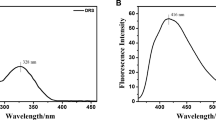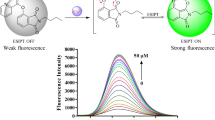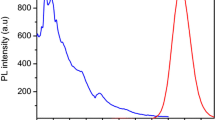Abstract
The rapid detection of Ni ions has important research and application value. This paper presents a novel specific turn-off fluorescence probe PCTMP-FS for detecting Ni2+ ions. The carbazole-based compound PCTMP is first synthesized via a two-step reaction. PCTMP-FS comprises PCTMP dispersed into a DMSO-H2O (fw = 30% v/v) mixed solvent. The probe demonstrates prominent selectivity and anti-interference abilities for detecting Ni2+ with a limit of detection (LOD) of 0.233 μM. The probe exhibits good applicability over a wide range of acidities. The detecting mechanism of the probe is due to the complex formed by PCTMP and Ni2+ (2:1), which destroys intramolecular charge transfer in the compound. The probe has good repeatability and demonstrates excellent stability and sensitivity for the detection of Ni2+ in real water samples.
Graphical abstract










Similar content being viewed by others
Data availability
All relevant data are within the manuscript and its supplement files.
References
Gupta, N., Singhal, D., & Singh, A. K. (2016). Highly selective colorimetric and reversible fluorometric turn-off sensors based on the pyrimidine derivative: Mimicking logic gate operation and potential applications. New Journal of Chemistry, 40, 641–650.
Yin, G., Yao, J., Hong, S., Zhang, Y., Xiao, Z., Yu, T., Li, H., & Yin, P. (2019). A dual-responsive colorimetric probe for the detection of Cu2+ and Ni2+ species in real water samples and human serum. The Analyst, 144, 6962–6967.
Han, Z., Yan, J., Tang, H. Q., He, Y., Zhu, Y., & Ge, Y. Q. (2017). Novel simple fluorescent sensor for nickel ions. Tetrahedron Letters, 58, 1254–1257.
Kabzińska, K., Cisek-Woźniak, A., Czajeczny, D., Mruczyk, K., & Wójciak, R. W. (2021). The influence of Li+ ions on pepsin and trypsin activity in vitro. Journal of Trace Elements in Medicine and Biology, 66, 126763126763.
Yu, T., Tian, X., Li, H., Li, W., Zhu, W., Zhou, H., Tian, Y., & Wu, J. (2016). A reversible and highly selective fluorescence “on-off-on” probe for detecting nickel ion in the mitochondria of living cells. Biosensors and Bioelectronics, 82, 93–98.
Ghaedi, M., Jaberi, S. Y. S., Hajati, S., Montazerozohori, M., Zarr, M., Asfaram, A., Kumawat, L. K., & Gupta, V. K. (2015). Preparation of iodide selective carbon paste electrode with modified carbon nanotubes by potentiometric method and effect of CuS-NPs on its response. Electroanalysis, 27, 1516–1522.
Razmi, H., & Dehghanzade, M. (2019). Highly selective and sensitive electrochemical determination of Ni(II) in real samples based on ion-imprinted polymer technology. Electroanalysis, 32, 198–206.
Azizi Khereshki, N., Mohammadi, A., Zavvar Mousavi, H., & Alizadeh, N. (2022). A novel thiosemicarbazide based chemosensor for colorimetric detection of Co2+ in commercial B12 vitamin and Co2+, Ni2+ simultaneously in aqueous media. Supramolecular Chemistry, 33, 513–526.
Vengaian, K. M., Britto, C. D., Sivaraman, G., Sekar, K., & Singaravadivel, S. (2015). Phenothiazine based sensor for naked-eye detection and bioimaging of Hg(ii) and F− ions. RSC Advances, 5, 94903–94908.
Christopher Leslee, D. B., Venkatachalam, U., Gunasekaran, J., Karuppannan, S., & Kuppannan, S. B. (2023). Synthesis of a quinoxaline–hydrazinobenzothiazole based probe—Single point detection of Cu2+, Co2+, Ni2+ and Hg2+ ions in real water samples. Organic & Biomolecular Chemistry, 21, 4130–4143.
Aroua, L. M., Ali, R., Albadri, A. E. A. E., Messaoudi, S., Alminderej, F. M., & Saleh, S. M. (2023). A new, extremely sensitive, turn-off optical sensor utilizing Schiff base for fast detection of Cu(II). Biosensors, 13, 359359.
Zhang, G., Huang, L., Xu, Y., Weng, S., & Ke, F. (2021). A 1,10-phenanthroline fluorescence probe for real-time visualization of Ni2+. Journal of the Iranian Chemical Society, 18, 2567–2573.
Wang, Y., Zhou, F., Meng, Q., Zhang, S., Jia, H., Wang, C., Zhang R., & Zhang, Z. (2021). A novel fluorescence probe for the reversible detection of bisulfite and hydrogen peroxide pair in vitro and in vivo. Chemistry—An Asian Journal, 16, 3419–3426.
Zhang, Y., Zhao, Y., Wu, Y., Zhao, B., Wang, L., Song, B., & Huang, C. (2021). Benzoindole-based bifunctional ratiometric turn-on sensor with an ICT effect for trapping of H+ and Al3+ in dual-channel cell imaging and samples. Spectrochimica Acta Part A: Molecular and Biomolecular Spectroscopy, 247, 119123119123.
Zhang, Y., Zhao, Y., Song, B., & Huang, C. (2021). Spectroscopic behavior and intracellular application of a highly sensitive UV-fluorescence double ratio probe based on water-soluble indole for detection acid pH. Dyes and Pigments, 188, 109205109205.
Kang, Y., & Wei, C. (2022). Crescent‐shaped carbazole derivatives as light‐up fluorescence probes for G‐quadruplex DNA and live cell imaging. Chemistry & Biodiversity, 19, e202101030e202101030.
Yin, J., Ma, Y., Li, G., Peng, M., & Lin, W. (2020). A versatile small-molecule fluorescence scaffold: Carbazole derivatives for bioimaging. Coordination Chemistry Reviews, 412, 213257213257.
Nayana, V., & Kandasubramanian, B. (2020). Polycarbazole and its derivatives: Progress, synthesis, and applications. Journal of Polymer Research, 27, 285285.
Pan, J., Ma, J., Liu, H., Zhang, Y., & Lu, L. (2021). The preparation of a special fluorescent probe with an aggregation-induced emission effect for detecting hydrazine in water. New Journal of Chemistry, 45, 21151–21159.
Ramírez, C. L., Mangione, M. I., Bertolotti, S. G., Arbeloa, E. M., & Parise, A. R. (2018). A photophysical and spectroelectrochemical study on N-phenyl-carbazoles and their oxidized species. Journal of Photochemistry and Photobiology A: Chemistry, 365, 199–207.
Dumat, B., Bordeau, G., Faurel-Paul, E., Mahuteau-Betzer, F., Saettel, N., Bombled, M., Metgé, G., Charra, F., Fiorini-Debuisschert, C., & Teulade-Fichou, M. P. (2011). N-phenyl-carbazole-based two-photon fluorescent probes: Strong sequence dependence of the duplex vs quadruplex selectivity. Biochimie, 93, 1209–1218.
Qi, J., Hu, X., Dong, X., Lu, Y., Lu, H., Zhao, W., & Wu, W. (2019). Towards more accurate bioimaging of drug nanocarriers: Turning aggregation-caused quenching into a useful tool. Advanced Drug Delivery Reviews, 143, 206–225.
Ruan, Z., Fan, C., Wang, X., Shao, D., Yang, X., He, W., Xu, T., Lin, J., & Tian, Z. (2024). A novel thioketal containing fluorescent dye for mercury(II) detection via Hg2+-triggered ACQ to AIE transformation. Dyes and Pigments, 222, 111835.
Zhang, Y., Zhao, Y., Zhou, A., Qu, Q., Zhang, X., Song, B., Liu, K., Xiong, R., & Huang, C. (2021). “Turn-on” ratiometric fluorescent probe: Naked-eye detection of acidic pH and citric acid (CA) by using fluorescence spectrum and its application in real food samples and zebrafish. Spectrochimica Acta Part A: Molecular and Biomolecular Spectroscopy, 261, 120014.
Zhang, Y., Zhao, Y., Song, B., Liu, K., Gu, J., Yue, Y., Xiong, R., & Huang, C. (2021). UV-fluorescence probe for detection Ni2+ with colorimetric/spectral dual-mode analysis method and its practical application. Bioorganic Chemistry, 114, 105103105103.
Santhoshkumar, S., Velmurugan, K., Prabhu, J., Radhakrishnan, G., & Nandhakumar, R. (2016). A naphthalene derived Schiff base as a selective fluorescent probe for Fe2+. Inorganica Chimica Acta, 439, 1–7.
Gu, Y.-Q., Shen, W.-Y., Mi, Y., Jing, Y.-F., Yuan, J.-M., Yu, P., Zhu, X.-M., & Hu, F.-L. (2019). Dual-response detection of Ni2+ and Cu2+ ions by a pyrazolopyrimidine-based fluorescent sensor and the application of this sensor in bioimaging. RSC Advances, 9, 35671–35676.
Li, S., Yue, T., Sun, W., Zhang, C., He, J., Han, M., Zhang, H., Yu, H., & Li, W. (2022). Intense removal of Ni (II) chelated by EDTA from wastewater via Fe3+ replacement–chelating precipitation. Process Safety and Environmental Protection, 159, 1082–1091.
Kumar, A., Chae, P. S., & Kumar, S. (2020). A dual-responsive anthrapyridone-triazole-based probe for selective detection of Ni2+ and Cu2+: A mimetic system for molecular logic gates based on color change. Dyes and Pigments, 174, 108092108092.
Irfan, A., Al-Sehemi, A. G., & Kalam, A. (2013). Structural, electronic and charge transfer studies of dianthra[2,3-b:2′,3′-f]thieno[3,2-b]thiophene and its analogues: Quantum chemical investigations. Journal of Molecular Structure, 1049, 198–204.
Huong, V. T. T., Nguyen, H. T., Tai, T. B., & Nguyen, M. T. (2013). π-Conjugated molecules containing naphtho[2,3-b]thiophene and their derivatives: Theoretical design for organic semiconductors. The Journal of Physical Chemistry C, 117, 10175–10184.
Jang, H. J., Jo, T. G., & Kim, C. (2017). A single colorimetric sensor for multiple targets: The sequential detection of Co2+and cyanide and the selective detection of Cu2+in aqueous solution. RSC Advances, 7, 17650–17659.
Song, Y., Tao, J., Wang, Y., Cai, Z., Fang, X., Wang, S., & Xu, H. (2021). A novel dual-responsive fluorescent probe for the detection of copper(II) and nickel(II) based on BODIPY derivatives. Inorganica Chimica Acta, 516, 120099120099.
Fegade, U., Marek, J., Patil, R., Attarde, S., & Kuwar, A. (2014). A selective fluorescent receptor for the determination of nickel (II) in semi-aqueous media. Journal of Luminescence, 146, 234–238.
Na, L.-P., Dou, L., Yan, Y.-J., Li, R.-Y., & Dong, W.-K. (2022). A new reversible aldehyde-appended salamo-like fluorogenic probe for cascade sensing of Ni2+ and HPO42− ions in aqueous medium. Journal of Photochemistry and Photobiology A: Chemistry, 432, 114061114061.
Weerasinghe, A. J., Oyeamalu, A. N., Abebe, F. A., Venter, A. R., & Sinn, E. (2016). Rhodamine based turn-on sensors for Ni2+ and Cr3+ in organic media: Detecting CN− via the metal displacement approach. Journal of Fluorescence, 26, 891–898.
Kumar, A., Virender, B., Mohan, K., Modi, M. A. U., & Din, and S. Kumar,. (2022). A highly selective ratiometric and colorimetric detection of Ni2+ and Cu2+ ions using Schiff base ligand. Journal of Molecular Structure, 1268, 133609133609.
Wang, K., Zhao, C., Guo, S., Lu, Y., Shen, Y., & Wang, C. (2019). A coumarin-based near-infrared fluorescent probe with a large stokes shift for the sequential recognition of Ni2+ and CN−: Performance research and quantum calculation. Journal of Photochemistry and Photobiology A: Chemistry, 382, 111943111943.
Xie, P., Zhu, Y., Huang, X., Gao, G., Wei, F., Guo, F., Jiang, S., & Wang, C. (2019). A novel probe based on rhodamine 101 spirolactam and 2-(2′-hydroxy-5′-methylphenyl)benzothiazole moieties for three-in-one detection of paramagnetic Cu2+, Co2+ and Ni2+. Spectrochimica Acta Part A: Molecular and Biomolecular Spectroscopy, 222, 117171.
Kumar, V., Singh, D., Kumar, P., Chaudhary, G., Singh, A. P., & Gupta, R. (2022). Turn-on fluorescent detection of nickel and zinc ions by two related chemosensors containing naphthalimide ring(s). Journal of Molecular Structure, 1261, 132901132901.
Pannipara, M., Al-Sehemi, A. G., Irfan, A., Assiri, M., Kalam, A., & Al-Ammari, Y. S. (2018). AIE active multianalyte fluorescent probe for the detection of Cu2+, Ni2+ and Hg2+ ions. Spectrochimica Acta Part A: Molecular and Biomolecular Spectroscopy, 201, 54–60.
Velmurugan, K., Prabhu, J., Raman, A., Duraipandy, N., Kiran, M. S., Easwaramoorthi, S., Tang, L., & Nandhakumar, R. (2018). Dual functional fluorescent chemosensor for discriminative detection of Ni2+ and Al3+ ions and its imaging in living cells. ACS Sustainable Chemistry & Engineering, 6, 16532–16543.
Lin, X., Zheng, Y., Jiang, L., Chen, H., & Wang, Q. (2018). Study of specific interaction between bis(p-phenylene)-34-crown-10-based substituted macrocycle and Ni2+. Journal of Fluorescence, 28, 725–728.
Banerjee, A., Sahana, A., Guha, S., Lohar, S., Hauli, I., Mukhopadhyay, S. K., Sanmartín Matalobos, J., & Das, D. (2012). Nickel(II)-induced excimer formation of a naphthalene-based fluorescent probe for living cell imaging. Inorganic Chemistry, 51, 5699–5704.
Manna, A. K., Mondal, J., Rout, K., & Patra, G. K. (2018). A benzohydrazide based two-in-one Ni2+/Cu2+ fluorescent colorimetric chemosensor and its applications in real sample analysis and molecular logic gate. Sensors and Actuators B: Chemical, 275, 350–358.
Acknowledgements
The authors are thankful to the Natural Science Foundation of Shanghai (No.15ZR1428500) for financial support.
Author information
Authors and Affiliations
Contributions
LW and JM provided the initial idea for this work; JM, as supervisor, provided support; LW contributed to the theoretical calculation and analysis of test data; JM and LW contributed to the paper writing.
Corresponding author
Ethics declarations
Interest statement
All authors declare no conflict of interest in the manuscript.
Supplementary Information
Below is the link to the electronic supplementary material.
Rights and permissions
Springer Nature or its licensor (e.g. a society or other partner) holds exclusive rights to this article under a publishing agreement with the author(s) or other rightsholder(s); author self-archiving of the accepted manuscript version of this article is solely governed by the terms of such publishing agreement and applicable law.
About this article
Cite this article
Wang, L., Wang, L. & Ma, J. Highly sensitive and specific detection of Ni2+ using a novel fluorometric probe in the DMSO-H2O system. Photochem Photobiol Sci 23, 527–537 (2024). https://doi.org/10.1007/s43630-024-00537-2
Received:
Accepted:
Published:
Issue Date:
DOI: https://doi.org/10.1007/s43630-024-00537-2




